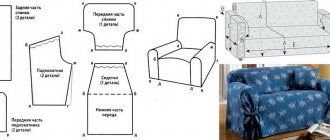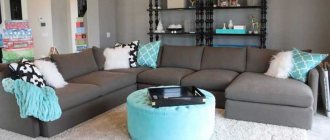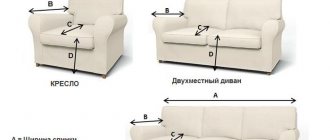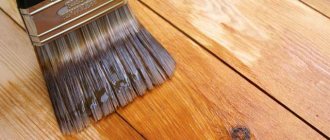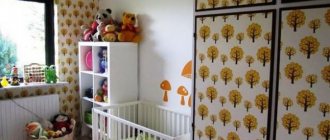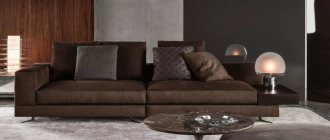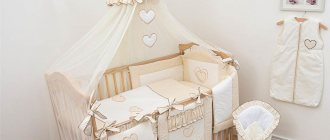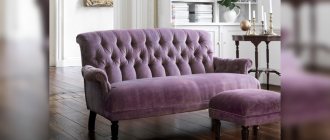When purchasing new upholstered furniture, few people think that after some time it will lose its original appearance. The fabric will wear out, the armrests will begin to shine, and difficult-to-remove stains or holes may appear. It’s easy to protect the upholstery of your favorite furniture or “give a second life” to old ones. All you have to do is sew a sofa cover with your own hands.
During daily use, upholstered furniture wears out the fastest.
Advantages of a self-produced product
- Compared to restoration, this is a cheaper method.
- It is convenient to use and easy to wash.
- Opportunity to create your own unique design.
- The process does not require professional training and takes several hours.
- You can make several models and experiment with the appearance.
- If there are chairs from different sets next to upholstered furniture that are completely out of harmony, additional covers made for them will solve the problem.
- Handmade products are highly valued.
The fabric fades, is wiped out in places, stains, puffs, and others appear on it.
Since the cover will experience a lot of stress at the seams, especially if the pattern is very tight, some seams can be stitched twice.
Design and construction
Before you start sewing, you need to decide what the future product should look like. To do this, you need to analyze the type of sofa you have. It can be two- or three-seater, with soft or wooden sides or no armrests at all. The most difficult thing is to sew a cover for a corner sofa with your own hands.
The fabric fades, is wiped out in places, stains, puffs and other marks that are not pleasing to the eye appear on it.
You need to carefully measure all the areas and details, draw them in a reduced form on paper, and then make a layout taking into account the direction of the pattern or fabric design, the grain line.
Moreover, it should consist of several rectangular elements and completely cover the surface of the upholstery. You can secure it with an elastic band. The sagging will be eliminated by cords or braid attached to the drawstring and tied to the legs. Additional elements such as frills and ribbons will add elegance.
Ordinary blankets or capes solve the problem only partially - they get confused, move out, and besides, they cover (protect) only the front part of the sofa.
There are many patterns on the Internet for creating models that resemble those offered in stores. So, if you decide to make covers for your sofa and armchairs with your own hands, you will find a diagram. For the set, you can add a universal chair cover with an elastic band, sewn by yourself.
Covers for sofas, chairs, and armchairs are a proven way to update upholstered furniture with a minimum of financial costs and effort.
Look at the photo how easily you can turn any furniture into a work of art using furniture covers.
Necessary materials:
- sewing machine with overcasting capability;
- tailor's tape or tape measure;
- ruler;
- pins;
- scissors;
- a piece of chalk or soap for marking;
- matching threads;
- and a little patience.
Renewing furniture - even with the most careful and careful treatment of furniture, over time it begins to shine, the fabric loses its color saturation, and wears out.
The most important thing you need to sew sofa covers with your own hands is fabric. The material for the bedspread must be durable, wear-resistant, and easy to clean. For these purposes it is recommended to use:
- jacquard;
- flock;
- Shinil with a plush surface;
- pleated;
- microfiber;
- leatherette;
- eco leather;
- natural or artificial fur.
The issue of updating and completely restoring the appearance can be fundamentally solved by reupholstery, which is associated with certain problems and risks.
Removable covers for upholstered furniture not only keep the upholstery of the furniture in its pure form, but also have a number of other useful advantages.
To make a Euro sofa cover with your own hands, you will have to purchase more elastic fabric.
Covers allow you to update only the outer, outer surface, without interfering with the inside of the sofa, which means that the factory assembly of the sofa (chair) is preserved, which will increase the service life.
Covers for sofas, covers for chairs or armchairs have become very fashionable again these days.
Manufacturing materials and tools
A sofa cover can be made from different fabrics. The choice depends on individual preferences. The easiest way to care for fleece and tapestry. They practically do not fade in the sun, they can be washed in an automatic machine.
| Velours | Looks impressive, but attracts dust and static electricity |
| Flock | Externally similar to velor, but costs less and has a shorter service life |
| Microfiber | The fabric is easy to care for, but easily absorbs and retains foreign odors for a long time. |
| Cotton | Natural fabric, does not cause allergic reactions, can be used for covers on children's furniture. Disadvantages: fades when washed and fades in the sun |
| Jacquard | Durable fabric that lasts a long time, maintaining color and structure. But the material can become very wrinkled and stretched during automatic spinning during machine washing. |
Stages of repairing a sofa with your own hands, taking into account the specifics of the malfunction.
The main requirements for the material for sewing a cover are practicality and hypoallergenicity (especially if you need to sew a blanket for children). Ease of care and cleaning is also very important. Color fastness matters. And, of course, it’s good when the fabrics are pleasant to the touch, this creates additional comfort.
You should purchase fabric in a store so that you have enough to spare when sewing. If there is still material left after cutting, you can use it to sew decorative sofa pillows to match the cover.
Velours
Jacquard
Microfiber
Flock
Cotton
Main stages of sewing
The first step is to measure the armrests, ottomans, seat and backrest. Then create a pattern and calculate the amount of material needed. Each piece must have seam allowances of at least 7 cm.
- All details are transferred to paper and cut out. The fabric should be laid out on a hard surface. The diagrams are superimposed on the material and outlined around the edge with a piece of chalk or soap.
- The cut parts are sewn down with a stitch, after which it is better to try on the product and secure it with pins. If it is small or loose, then you need to adjust the pattern or change the size of the allowances.
- After adjusting to the dimensions of the furniture, you need to remove excess parts of the fabric, leaving only 3 cm for allowances. Then you should overcast and sew the edges. It is better to wash the resulting blanket in cool water and iron it.
- To create covers for sofas and armchairs with elastic with your own hands, you will have to perform several additional operations with the bottom edge. To do this, you need to turn it inside out and draw a straight line with a pencil along which the elastic will go. Then, you need to secure it parallel to the edge of the marking, securing it every 5-10 cm with pins or thread. To sew in elastic, you will need a sewing machine that allows you to create a three-step (elastic) seam.
At the same time, the cover does not require special installation - you just need to put it on the sofa and fasten the Velcro, buttons or zipper.
You will get a wonderful cover for furniture - quickly and easily.
Decoration options
If the base of the bedspread is ready, you can begin to refine it. It would be nice if the sofa cover and pillows complement each other. This composition will fit perfectly into the interior.
Effective ways to remove the smell of cat urine from a sofa and armchairs
Today the following variations are relevant:
- Embroidery with floss threads. Abstract ornaments, plot images, various figures, and plants look beautiful. Many craftswomen also like to embroider with ribbons and beads.
- Fringe. It is easy to recreate from threads. This edging is appropriate for knitted blankets on the sofa.
- Applications. Made from textiles, leather, fur. Flights of imagination are welcome here - any shapes and pictures are available.
- Edging tapes. The most popular are satin.
- Bows and ruffles. Suitable for light summer capes and bedspreads.
To prevent the bedspread from falling off the sofa or sliding, it is appropriate to attach special fastenings. These can be rivets, ribbons or braid. But the most convenient ones are elastic bands, silicone sheets, and Velcro. The latter option is good, but over time it wears out and becomes unusable.
Embroidery floss
Patchwork applique
Fringe
Edging tapes
Ruffles
How to knit a cover with your own hands. Step-by-step instruction
To knit a universal sofa cover with your own hands, you will have to spend a lot of time and effort. The product can be several interconnected canvases, knitted with knitting needles or a set of square crocheted motifs.
Furniture protection - covers will be a real salvation if there are small children or pets in the house.
A cover for a sofa is really convenient both in practical terms and in terms of changing the surroundings.
To create a knitted cover, you will need to purchase thick threads, as well as working tools. It is better to choose the pattern and color scheme in accordance with the interior. You can use different types of thread. Just as in the previous case, you will have to take measurements of the furniture and prepare a pattern, which must be followed in the process of knitting the fabric.
They, without limiting the use of furniture by all family members, will help preserve the original appearance of the furniture.
It will retain the natural color of the upholstery for a long time and will not be damaged by the claws of pets.
If “motifs” are used for manufacturing, it is recommended to measure the area of the pattern and one square. Based on the obtained dimensions, calculate the number of required squares and skeins of thread.
They will become a kind of barrier, preventing the appearance of puffs and scratches; animal hair does not stick or roll off in the upholstery.
Your furniture will be reliably protected from dust and grime.
If the product is created from knitted fabrics, it is better to calculate the surface area in advance. Once in a sewing store, pay attention to the thread label. As a rule, it indicates two numbers corresponding to the knitting density. Knowing them, it is not difficult to calculate (on your own or by contacting an employee) the required number of skeins.
The fabric has a pronounced stretch effect, restoring its shape after pressure.
Many small fibers are applied to a dense fabric base with the help of glue, from which a velvety surface is obtained.
Instructions on how to sew covers for a sofa, with an explanation of all the details
Over time, an old sofa loses its attractiveness, or after another renovation it does not fit into the overall design of the room. You don't have to get rid of the furniture. You can sew a cover for a sofa in an easy way, which is quite simple; it will require a little time, fabric and a minimum of tools for work.
Are there small children or pets in the house? The removable option is the most ideal. The cover is easily removed and washed. If the house has new furniture, a removable model will help protect the furniture, last a long time, and maintain its impeccable appearance. How to sew a sofa cover using an easy method is written in the article.
Choosing shape and sizes
Some owners change the upholstery, but most prefer to purchase a removable cover. Convenient option, easy to change. It is better to sew a product on the sofa with your own hands in two versions, for a festive, ordinary day.
On holiday, decorate upholstered furniture with bright, elegant capes. The living room will take on a solemn look. On weekdays you will need practical upholstery.
The photo on the right shows different models of capes, covers of different shapes, in an unusual design.
Before you sit down to sew a cover with your own hands, you need to think about the shape and size. There are models that completely cover furniture, handrails, backs, and legs. The fabric completely covers all parts, creating the illusion of the whole flying. The models are good for a home decorated in romantic, English, classic, and modern styles. The click-clack element on the sofa will work well.
Basic measurements
Those who appreciate practicality will like covers made exactly to the size of the furniture, or a model consisting of a “seat” and armrests. Various ruffles, flounces, and many bows are inappropriate.
Practical pockets on the side of the cover and armrests will serve as both decoration and “shelves” for storing useful things. Relaxing with reading is a favorite pastime for most; you can put an unread book, glasses, newspaper, or magazines in your pocket.
The models are suitable for styles such as: country, high-tech, rustic, modern. The option is successful if there is a sofa in the house.
The size of the cover depends on the design style, shape, and requirements of the owners. It should be taken into account that if the product covers only part of the sofa, then the color should be harmonious with the furniture.
If the sofa is completely covered with a cover, then the color does not matter; all that remains is to take into account the overall design of the room.
Are you planning to sew a cover for a corner sofa with your own hands? It is necessary to take into account that it will take a little more fabric, the pattern will be more complicated. But there shouldn’t be any difficulties here either.
On the corner sofa
Cape
With ties
With frills
Material
Any work related to needlework begins with the choice of fabric. When choosing a fabric, it is necessary to take into account that the main function of the cover is to protect the sofa upholstery from dust and various contaminants.
To sew an element on a sofa, you can purchase any material, there is a wide range. The following are very popular:
- velours;
- flock;
- Teflon flock;
- microfiber;
- cotton;
- jacquard.
Each fabric has its own characteristics and properties. No one can say which material is better. When choosing, you need to pay attention to the composition of the fiber. For furniture, preference is given to materials containing wool and cotton.
Velours
Jacquard
Microfiber
Flock
Cotton
The fabric for the cover must meet the requirements:
- practicality is important - the fabric should not require complex care;
- hypoallergenic - a person spends a lot of time on the sofa, the fabric must be safe for human health;
- should not accumulate static electricity;
- it is desirable that the cover can be washed or dry-cleaned in the future;
- the fabric should be soft to the touch and at the same time dense;
- The color must last for a long time.
When choosing, professionals recommend taking into account:
- External bright appearance is not the main indicator. The fabric must be wear-resistant;
- if there are babies and children in the house, then you need to choose a fabric that is durable and resistant to dirt and sharp claws;
- good fabric with special impregnation with fat and water-repellent. Then housewives will not be afraid of spilled tea or overturned food. The advantage of this material is that the cover is easy to wash.
Process steps
You should not choose a complex cut of the cover. Even if it’s a sofa with shaped handrails and an unusual back shape. A cover for a corner sofa or claque can also be simple in cut. Once the fabric has been selected, all that remains is to calculate the yardage. To make work easier, preference should be given to three-dimensional models, or models that cover the back of the sofa and handrails.
If the upholstered furniture does not have armrests, you can get by with a cape. Its sizes are different. If you don’t have the skills to work with a needle, but want to sew a practical fabric decorative item for your sofa, then an easy way is to make a throw.
Volumetric models are easy to cut, but require a little more fabric. It’s easy to calculate the footage:
- measure the height and width of the back of the sofa;
- measure the dimensions of the handrails;
- estimate how the details will be arranged on the fabric when cutting;
- add a few centimeters on all sides for seam allowances;
- add 10-15 centimeters for hems and trims.
Volumetric models are often sewn with one piece of fabric. The cover stretches over the entire sofa and is attached to the armrests. Straps, straps, buttons, and buttons are used as fasteners. The attached photo on the right shows different decorating methods. When the model is thought up, you need to prepare everything you need for work and you can start sewing covers for the sofas.
Materials and tools
Let's consider making the simplest type of cover - a cape. In this model, you will need to sew a sofa cover that is continuous for the back and seat. Separately cut and sew the armrests, connect the parts into a single whole and design the finished product. Everything is done simply.
Decoration
You can decorate the finished product with bows, appliques or stripes. To decorate the armrests, a decorative rope with a diameter of 1 cm is best suited. Framing with a wide braid or ribbon will help to emphasize the lower part.
Covers for a sofa (chairs) can radically change the visual perception of furniture.
The isoprene layer plus dense pile allows you to avoid puffs.
